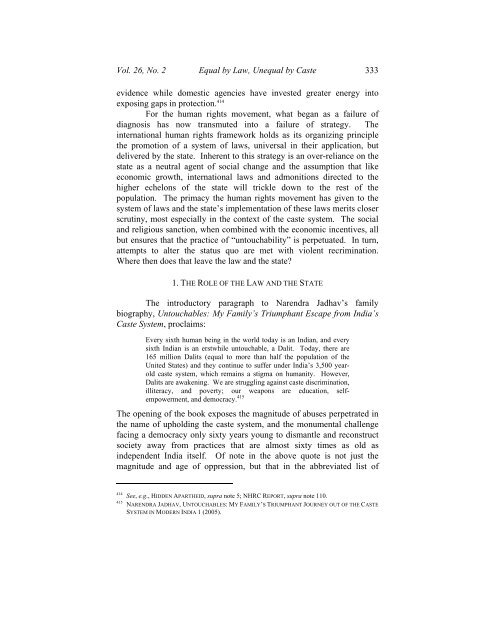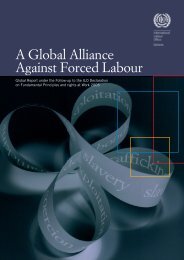equal by law, unequal by caste - International Dalit Solidarity Network
equal by law, unequal by caste - International Dalit Solidarity Network
equal by law, unequal by caste - International Dalit Solidarity Network
Create successful ePaper yourself
Turn your PDF publications into a flip-book with our unique Google optimized e-Paper software.
Vol. 26, No. 2 Equal <strong>by</strong> Law, Un<strong>equal</strong> <strong>by</strong> Caste 333evidence while domestic agencies have invested greater energy intoexposing gaps in protection. 414For the human rights movement, what began as a failure ofdiagnosis has now transmuted into a failure of strategy. Theinternational human rights framework holds as its organizing principlethe promotion of a system of <strong>law</strong>s, universal in their application, butdelivered <strong>by</strong> the state. Inherent to this strategy is an over-reliance on thestate as a neutral agent of social change and the assumption that likeeconomic growth, international <strong>law</strong>s and admonitions directed to thehigher echelons of the state will trickle down to the rest of thepopulation. The primacy the human rights movement has given to thesystem of <strong>law</strong>s and the state’s implementation of these <strong>law</strong>s merits closerscrutiny, most especially in the context of the <strong>caste</strong> system. The socialand religious sanction, when combined with the economic incentives, allbut ensures that the practice of “untouchability” is perpetuated. In turn,attempts to alter the status quo are met with violent recrimination.Where then does that leave the <strong>law</strong> and the state?1. THE ROLE OF THE LAW AND THE STATEThe introductory paragraph to Narendra Jadhav’s familybiography, Untouchables: My Family’s Triumphant Escape from India’sCaste System, proclaims:Every sixth human being in the world today is an Indian, and everysixth Indian is an erstwhile untouchable, a <strong>Dalit</strong>. Today, there are165 million <strong>Dalit</strong>s (<strong>equal</strong> to more than half the population of theUnited States) and they continue to suffer under India’s 3,500 yearold<strong>caste</strong> system, which remains a stigma on humanity. However,<strong>Dalit</strong>s are awakening. We are struggling against <strong>caste</strong> discrimination,illiteracy, and poverty; our weapons are education, selfempowerment,and democracy. 415The opening of the book exposes the magnitude of abuses perpetrated inthe name of upholding the <strong>caste</strong> system, and the monumental challengefacing a democracy only sixty years young to dismantle and reconstructsociety away from practices that are almost sixty times as old asindependent India itself. Of note in the above quote is not just themagnitude and age of oppression, but that in the abbreviated list of414 See, e.g., HIDDEN APARTHEID, supra note 5; NHRC REPORT, supra note 110.415 NARENDRA JADHAV, UNTOUCHABLES: MY FAMILY’S TRIUMPHANT JOURNEY OUT OF THE CASTESYSTEM IN MODERN INDIA 1 (2005).
















